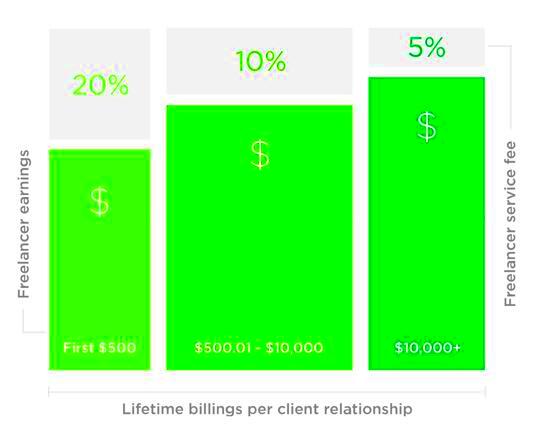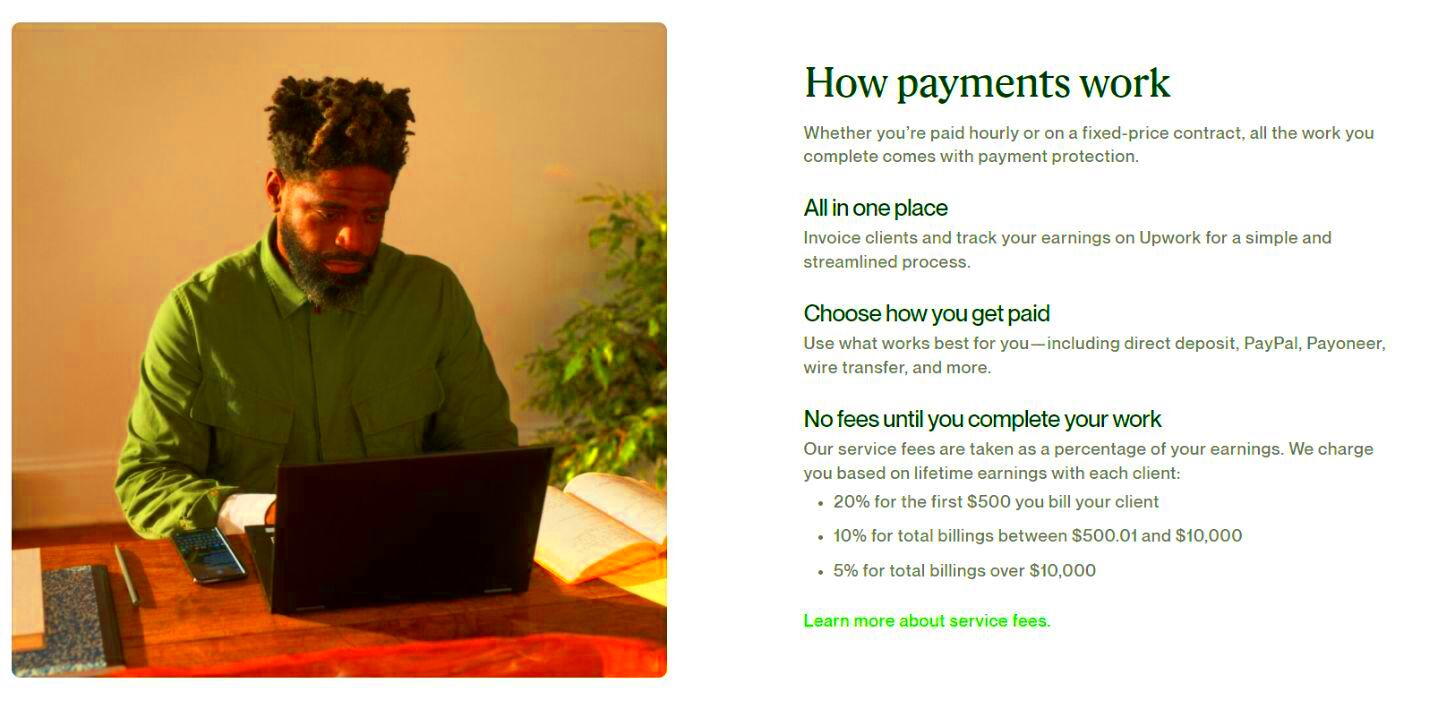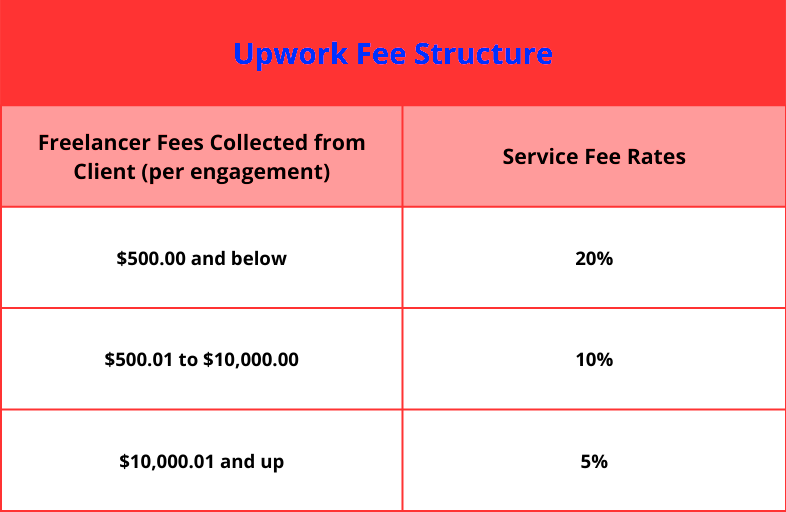For freelancers using Upwork, understanding the platform's fee structure is essential. Upwork charges service fees on the income earned through the platform, affecting how much freelancers actually receive. These fees help maintain the platform and support its features, but they can impact earnings if not fully understood. Knowing how these fees work can help freelancers manage their rates and expectations better.
Understanding Service Fees on Upwork

Upwork applies service fees to every payment freelancers receive from clients. These fees depend on the total earnings a freelancer accumulates with a particular client. Upwork’s service fee is deducted from each payment before the funds reach the freelancer’s account.
Here’s a breakdown of the main points about Upwork’s service fees:
- Sliding Scale Fees: Upwork’s fees decrease as the lifetime earnings with a client increase, encouraging long-term client relationships.
- Project-Based Fees: Freelancers are charged based on each project or milestone, so earnings from multiple clients will each have fees applied separately.
- Consistency: Upwork consistently applies these fees, making them predictable once understood.
While these service fees are a standard part of using Upwork, they can affect net income, especially for freelancers working with new clients. Understanding these costs in advance helps freelancers set their rates accordingly and decide when it might be worthwhile to build a long-term relationship with a client.
Also Read This: Adding Freelance Work to Your Resume Sample
How the Sliding Scale Fee Structure Works

Upwork’s sliding scale fee structure aims to reward freelancers for long-term client relationships. The service fee percentage decreases based on how much a freelancer has earned from a specific client over time. This structure is broken down as follows:
| Lifetime Earnings with Client | Service Fee Percentage |
|---|---|
| $0 – $500 | 20% |
| $500.01 – $10,000 | 10% |
| $10,000+ | 5% |
This means that initially, freelancers pay a higher 20% fee when starting with a new client. As earnings grow, fees are gradually reduced to 10% and then to 5% after reaching $10,000 in lifetime earnings with the same client. This system benefits freelancers who build ongoing relationships, allowing them to retain more of their earnings over time.
The sliding scale encourages freelancers to nurture longer-term projects and repeat clients, ultimately reducing their overall service fees.
Also Read This: How to Block Someone on Fiverr
Additional Charges on Upwork

Aside from the standard service fees, Upwork freelancers may encounter a few other charges that can affect their earnings. These fees typically cover extra services and payment processing. Being aware of these can help freelancers plan their finances better and avoid unexpected deductions.
Here are some additional charges freelancers might face:
- Withdrawal Fees: Upwork charges a fee for transferring funds from Upwork to your bank or other payment options. For instance, direct-to-bank transfers have a small fee, and PayPal or Payoneer transfers may also involve minimal costs.
- Currency Conversion Fees: If your payment is in a different currency than your Upwork account, you might be charged a currency conversion fee. This fee helps cover the cost of converting payments and varies depending on the currency involved.
- Membership Plans: While the basic membership is free, Upwork also offers a Plus membership plan for $14.99 per month. This paid plan includes benefits like additional Connects, which are essential for bidding on projects, and visibility features that help freelancers stand out to clients.
These charges, though generally small, can add up, especially for freelancers working on smaller projects or using multiple withdrawal methods. Being aware of these potential costs allows freelancers to select the most cost-effective options available on Upwork.
Also Read This: How to Promote Yourself on Fiverr
Comparing Upwork Fees with Other Freelance Platforms
When deciding on a freelance platform, it’s essential to consider the fee structure, as it can significantly impact your earnings. Upwork’s fees can seem high to some, but they’re comparable to or even lower than those of other platforms, depending on the specific service provided.
Here’s a quick comparison of Upwork’s fees with other popular freelance sites:
| Platform | Service Fee Range | Special Considerations |
|---|---|---|
| Upwork | 5% - 20% (based on lifetime earnings with a client) | Lower fees for long-term clients |
| Fiverr | 20% | Flat rate on all projects, no reduction |
| Freelancer.com | 10% - 20% | Higher fees for fixed-price projects |
| Toptal | 20%+ | Typically reserved for high-end freelancers |
While Upwork offers a sliding scale that rewards longer-term client relationships, platforms like Fiverr apply a flat fee on all transactions. Freelancer.com, meanwhile, has similar fees to Upwork but does not offer a sliding scale. Toptal, known for its exclusive client base, typically has higher fees. Each platform has unique features, so choosing one depends on your career goals and preferred fee structure.
Also Read This: How to Start a Service on Fiverr
Tips for Reducing Upwork Fees
Although Upwork’s fees are standard, freelancers can apply certain strategies to minimize the impact of these charges. Here are some effective tips for keeping more of your earnings:
- Build Long-Term Client Relationships: Upwork’s sliding scale rewards loyalty with reduced fees. By focusing on building lasting relationships with clients, you can eventually pay only 5% in fees, allowing you to retain more income.
- Bid on Higher-Value Projects: Since fees are calculated per project, larger projects can offer better value. For example, working on a $1,000 project (10% fee) instead of two $500 projects (20% fee) saves on fees.
- Choose Cost-Effective Withdrawal Options: Opt for payment methods that offer lower withdrawal fees, such as direct-to-bank transfers over PayPal, to save on additional charges.
- Optimize Connects Usage: Efficiently using Connects (Upwork’s bidding currency) can help you bid on the best projects without overspending. The Plus membership can also provide more Connects if you regularly need them.
By taking these steps, freelancers can manage Upwork’s fees more effectively, ensuring they maximize their earnings while working on the platform.
Also Read This: How to Link Your Bank Account to Fiverr
Frequently Asked Questions about Upwork Fees
Many freelancers have questions about how Upwork's fees work and what they can expect in different situations. Here are answers to some common questions that help clarify Upwork’s fee structure:
Q: Why does Upwork charge a service fee?
A: Upwork’s service fees help maintain the platform, fund new features, and provide support for freelancers and clients. These fees also help ensure secure transactions and quality control across the platform.
Q: Is it possible to avoid the service fee on Upwork?
A: No, all freelancers are required to pay the service fee on Upwork. However, the sliding scale reduces the fee for long-term clients, which can help lower costs.
Q: How can I check the fees I’ve paid?
A: Upwork provides an earnings report, accessible through your account dashboard, that details service fees, earnings, and other financial transactions. This report helps freelancers keep track of total fees paid and net income over time.
Q: What happens if I work with the same client on multiple projects?
A: Upwork calculates fees based on lifetime earnings with each client. If you work with the same client on multiple projects, these earnings are combined for the sliding scale. This can reduce your fee percentage if you reach higher earning thresholds with that client.
Q: Do I pay fees on bonuses or tips from clients?
A: Yes, Upwork’s service fee applies to all payments received, including bonuses, tips, and milestone payments. The fee percentage follows the same sliding scale based on total client earnings.
Q: Are there any hidden fees on Upwork?
A: Apart from the service fee, withdrawal fees, and potential currency conversion charges, there are no hidden fees on Upwork. Any additional charges are clearly communicated within the payment and withdrawal options.
Conclusion on Upwork Charges for Freelancers
Understanding Upwork's fee structure helps freelancers make informed decisions about their work and earnings. Although service fees are a necessary part of the platform, Upwork offers ways to reduce them, such as the sliding scale for long-term clients. By knowing these details, freelancers can plan their rates and projects to maximize their income on Upwork.




